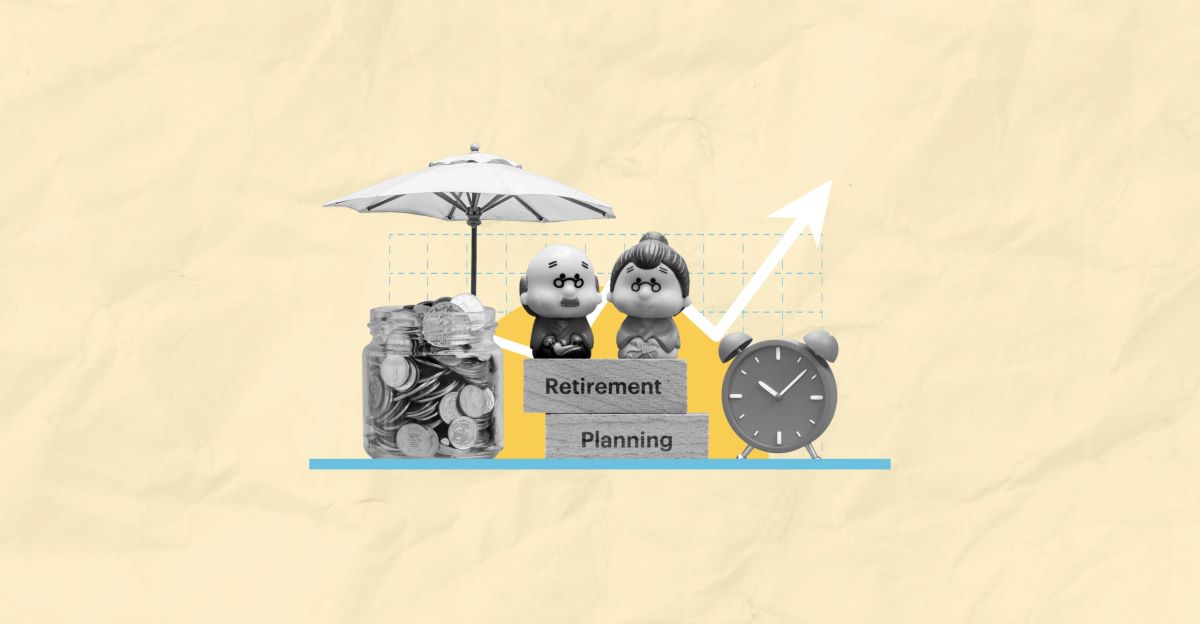Home>Finance>How Divorcees Can Restart Their Retirement Planning


Finance
How Divorcees Can Restart Their Retirement Planning
Published: January 21, 2024
Are you a divorcee looking to get back on track with your retirement planning? Discover essential financial tips and strategies to restart your retirement savings and secure a bright financial future.
(Many of the links in this article redirect to a specific reviewed product. Your purchase of these products through affiliate links helps to generate commission for LiveWell, at no extra cost. Learn more)
Table of Contents
- Introduction
- Evaluating Current Retirement Plan
- Redefining Financial Goals
- Assessing Assets and Liabilities
- Rebuilding Retirement Savings
- Maximizing Retirement Contributions
- Adjusting Investment Strategy
- Managing Retirement Income
- Updating Beneficiary Designations
- Seeking Professional Financial Advice
- Conclusion
Introduction
Divorce can be a life-altering event that affects all aspects of a person’s life, including their retirement planning. Many divorcees find themselves needing to start over and rebuild their financial foundation, including their retirement savings. In such circumstances, it is crucial for divorcees to evaluate their current retirement plan and make necessary adjustments to ensure a secure future.
In this article, we will dive into the steps that divorcees can take to restart their retirement planning and set themselves up for a comfortable and financially stable retirement. From redefining financial goals to seeking professional financial advice, each step is designed to provide divorcees with the tools and knowledge they need to navigate the complexities of retirement planning post-divorce.
While it may seem daunting to start fresh, it’s important to remember that divorcees have the opportunity to regain control of their financial future and create a retirement plan that aligns with their new circumstances and goals. With careful planning and strategic decision-making, divorcees can build a solid foundation for retirement and enjoy the peace of mind that comes with a well-funded retirement nest egg.
So, whether you are recently divorced or have been divorced for some time without giving much thought to your retirement planning, read on to discover how you can restart your retirement planning journey and set yourself up for a prosperous future.
Evaluating Current Retirement Plan
After a divorce, it is crucial to assess the status of your current retirement plan. This involves reviewing any existing retirement accounts, such as 401(k)s, IRAs, or pensions, and understanding how they may have been impacted by the divorce settlement.
Start by gathering all relevant documentation, such as divorce decrees, property settlements, and any documents related to the division of retirement assets. These will provide invaluable information about the current state of your retirement savings.
It’s important to consider whether any retirement accounts were divided or awarded to your former spouse during the divorce settlement. If so, you will need to determine the value of the remaining accounts and adjust your retirement goals accordingly.
Additionally, take note of any changes in your financial situation that may affect your retirement plan. Consider factors such as alimony payments, child support, or changes in income. These changes may impact your ability to contribute to retirement accounts or influence your overall budget for retirement savings.
Once you have a clear understanding of your current retirement plan, you can identify any gaps or areas that need attention. Evaluate whether your current savings and investments align with your desired retirement lifestyle. Determine if you need to make adjustments to your financial goals, such as retiring at a later age or exploring new investment strategies.
By evaluating your current retirement plan, you can gain a clearer picture of where you stand financially and make informed decisions about how to rebuild your retirement savings post-divorce. It’s also a good time to seek professional advice from a financial planner or advisor who can provide expertise tailored to your specific situation.
Redefining Financial Goals
After a divorce, it is important to take a step back and reassess your financial goals, especially when it comes to retirement. Divorce often brings significant changes to your financial situation, which may require adjusting your retirement goals accordingly.
Start by considering your desired retirement age. Has the divorce impacted your ability to retire at your original target age? If so, it may be necessary to extend your working years to rebuild your retirement savings. This might involve reevaluating your career path, seeking new job opportunities, or exploring options for part-time or freelance work.
Next, reassess your retirement lifestyle expectations. Are you still aiming for the same level of comfort and activities you had envisioned before the divorce? Depending on the financial impact of the divorce, you may need to revise your retirement budget and make necessary lifestyle adjustments.
Another important aspect to consider is your risk tolerance. Divorce can bring about financial uncertainties, and it is essential to reassess your risk tolerance to ensure that your investment strategy aligns with your current comfort level. This may involve modifying your investment portfolio to be more conservative or seeking professional advice to create a suitable risk management plan.
Finally, set realistic savings goals. Take into account any financial obligations resulting from the divorce settlement, such as alimony or child support. Evaluate your income and expenses to determine how much you can allocate towards retirement savings each month. While it may require making some sacrifices or reevaluating your spending habits, setting realistic savings goals is crucial for rebuilding your retirement nest egg.
By redefining your financial goals after a divorce, you can set yourself on a path that aligns with your new circumstances and ensures a financially secure future. Remember, it’s normal for goals to evolve over time, especially after significant life events like divorce. Adjusting your financial goals will help you navigate the path of retirement with confidence and peace of mind.
Assessing Assets and Liabilities
After a divorce, it is crucial to assess your assets and liabilities to get a clear picture of your financial standing. This evaluation will enable you to make informed decisions about how to rebuild your retirement savings effectively.
Begin by creating a comprehensive list of your assets, including bank accounts, investments, real estate, and any other valuable possessions. Take note of any changes in ownership resulting from the divorce settlement and update the titles or deeds accordingly.
Next, compile a list of your liabilities, such as outstanding debts, mortgages, or loans. Determine the interest rates, monthly payments, and remaining balance for each liability. This information will help you understand your financial obligations and make strategic decisions about how to allocate your resources.
It is essential to analyze the impact of your liabilities on your retirement planning. High-interest debts can hamper your ability to save for retirement, so consider devising a plan to pay off these debts efficiently. Prioritize the repayment of debts with higher interest rates and explore options such as debt consolidation or refinancing to lower your overall monthly payments.
In addition to assessing your current assets and liabilities, consider how your divorce settlement may have affected your retirement savings. If retirement assets were divided or awarded to your former spouse, adjust your expectations accordingly and determine how to replenish those funds over time.
Adopting a holistic approach to assessing your financial situation will help you identify opportunities to optimize your retirement savings. This could involve downsizing your current living arrangements, selling non-essential assets, or exploring part-time work to generate additional income for retirement.
Ultimately, by thoroughly assessing your assets and liabilities, you can make informed decisions about how to effectively manage your finances and rebuild your retirement savings post-divorce. Seek professional advice from a financial planner or advisor if needed, as they can provide valuable insights and guidance tailored to your specific circumstances.
Rebuilding Retirement Savings
Rebuilding retirement savings after a divorce requires careful planning and discipline. While the process may seem challenging, it is entirely possible to regain financial stability and set yourself up for a comfortable retirement. Here are some steps to help you rebuild your retirement savings post-divorce:
1. Create a budget: Start by evaluating your income and expenses to create a realistic budget. Identify areas where you can cut back on expenses and allocate more funds towards retirement savings. Stick to your budget to ensure you are consistently contributing to your retirement accounts.
2. Increase contributions: If possible, contribute more to your retirement accounts than the minimum required amount. Take advantage of catch-up contributions if you are 50 or older, as this can help accelerate your savings growth.
3. Automate savings: Set up automatic transfers from your paycheck to your retirement accounts. This ensures that a portion of your income goes towards savings without any effort on your part.
4. Take advantage of employer benefits: If your employer offers a retirement savings plan, such as a 401(k) with a matching contribution, take full advantage of it. Contribute at least enough to receive the maximum employer match, as this is essentially free money that boosts your retirement savings.
5. Consider downsizing: Evaluate your current housing situation and determine if downsizing is a viable option. Moving to a smaller, more affordable home can free up funds that can be redirected towards retirement savings.
6. Generate additional income: Explore ways to generate extra income, such as taking on a part-time job, freelancing, or starting a side business. The additional income can be allocated towards building your retirement savings.
7. Stay disciplined: Rebuilding retirement savings requires discipline and consistency. Stick to your savings plan and avoid unnecessary withdrawals or expenses that can hinder your progress.
Remember, rebuilding retirement savings takes time and patience. Pay attention to market trends and adjust your investment strategy accordingly. Seeking guidance from a financial advisor can also provide valuable insights and personalized strategies for accelerating your savings growth.
By implementing these strategies and maintaining a focused approach, you can rebuild your retirement savings post-divorce and secure a financially stable future.
Maximizing Retirement Contributions
When rebuilding your retirement savings after a divorce, maximizing your retirement contributions is an essential step to accelerate your savings growth. By taking advantage of various contribution limits and strategies, you can bolster your retirement nest egg. Here are some ways to maximize your retirement contributions:
1. Contribute to tax-advantaged accounts: Take advantage of retirement accounts with tax benefits, such as a 401(k) or an Individual Retirement Account (IRA). These accounts offer tax-deferred or tax-free growth, allowing your contributions to compound over time.
2. Maximize employer match: If your employer offers a matching contribution to your retirement plan, make sure to contribute at least enough to receive the full match. It’s essentially free money and a significant boost to your retirement savings.
3. Utilize catch-up contributions: If you are 50 or older, take advantage of catch-up contributions allowed in some retirement accounts. For example, in 2021, individuals aged 50 and older can contribute an extra $6,500 to their 401(k) on top of the standard contribution limit.
4. Consider a Roth option: If available, contribute to a Roth 401(k) or Roth IRA. While contributions to Roth accounts are made with after-tax income, withdrawals in retirement are tax-free. This can provide flexibility in managing your tax liability in retirement.
5. Evaluate contribution limits: Stay informed about annual contribution limits for each retirement account you hold. For 401(k)s and IRAs, these limits may change each year. Make sure you contribute the maximum allowable amount each year to take full advantage of tax benefits and savings growth potential.
6. Consider a Health Savings Account (HSA): If eligible, contribute to an HSA and use it as a supplemental retirement savings vehicle. HSAs offer triple tax advantages – contributions are tax-deductible, contributions and investment growth are tax-free, and qualified withdrawals for medical expenses are tax-free.
7. Coordinate spousal contributions: If your divorce settlement includes spousal support, consider coordinating retirement contributions with your ex-spouse. This can help both parties maximize their retirement savings while staying within the individual contribution limits.
It’s important to consult with a financial advisor or tax professional to ensure you understand the specific rules and limitations of different retirement accounts and contribution strategies. They can help you develop a tailored plan to maximize your retirement contributions based on your unique circumstances.
By maximizing your retirement contributions, you can expedite the growth of your retirement savings and increase your financial security as you rebuild your retirement plan post-divorce.
Adjusting Investment Strategy
After a divorce, it is crucial to reassess and adjust your investment strategy to align with your new financial situation and retirement goals. Here are some considerations to help you make appropriate adjustments:
1. Risk tolerance: Evaluate your risk tolerance and adjust your investment portfolio accordingly. Divorce can introduce financial uncertainties, and you may prefer a more conservative approach to investing. Speak with a financial advisor to determine the appropriate level of risk for your investment portfolio.
2. Diversification: Review your investment portfolio and ensure that it is properly diversified. Diversification helps spread risk across various asset classes and reduces the impact of market volatility on your overall portfolio. Consider diversifying across stocks, bonds, mutual funds, real estate, and other investment options.
3. Time horizon: Assess your new retirement time horizon. If the divorce settlement has impacted your retirement plans, you may need to adjust the timeline for reaching your retirement goals. This adjustment may influence the allocation of your investments and the level of risk you can afford to take.
4. Regular portfolio reviews: Schedule regular reviews of your investment portfolio to ensure it continues to align with your goals and risk tolerance. Life events, such as divorce, can prompt the need for frequent reassessment and adjustments to your investment strategy.
5. Seek professional advice: Consider consulting with a financial advisor who specializes in post-divorce financial planning. They can provide expert guidance on adjusting your investment strategy and help create a plan that addresses your unique needs and goals.
6. Dollar-cost averaging: If you have a lump sum of money from a divorce settlement or other sources, consider using dollar-cost averaging to invest the funds gradually over time. This strategy helps mitigate the risk of investing a significant sum at the wrong time and allows for potential market fluctuations.
7. Stay informed: Keep yourself updated on market trends and economic conditions. Stay informed about investment news and seek educational resources to enhance your understanding of investment principles and strategies.
Remember, adjusting your investment strategy is an ongoing process. Regularly monitor and evaluate your portfolio’s performance, and make adjustments as needed. Working with a financial professional can provide valuable expertise and help you navigate the complexities of investing post-divorce.
By adjusting your investment strategy, you can position yourself for long-term financial growth and ensure that your investments align with your new financial circumstances and goals.
Managing Retirement Income
As you approach retirement after a divorce, it’s important to develop a strategy for managing your retirement income. The following steps can help you effectively manage and make the most of your retirement income:
1. Determine your retirement income sources: Identify all potential sources of retirement income, such as Social Security benefits, pensions, annuities, and any other retirement accounts or investments. This will give you a clear picture of the income streams available to you in retirement.
2. Understand the tax implications: Evaluate the tax implications of each income source and develop a retirement income plan that minimizes your tax obligations. Consulting with a tax professional can help you make informed decisions on how to optimize your retirement income from a tax perspective.
3. Budget for essential and discretionary expenses: Create a comprehensive budget that separates essential expenses (such as housing, healthcare, and utilities) from discretionary expenses (such as travel, entertainment, and hobbies). This will help you allocate your retirement income efficiently and prioritize your spending.
4. Establish an emergency fund: Set aside a portion of your retirement income as an emergency fund to cover unexpected expenses or financial hardships. Aim to have at least three to six months’ worth of living expenses readily available in a liquid and accessible account.
5. Consider a sustainable withdrawal rate: Determine a sustainable withdrawal rate from your retirement accounts to ensure that you can maintain your standard of living throughout retirement. Withdrawal rates are typically based on factors such as life expectancy, investment returns, and anticipated expenses. Consult with a financial advisor to establish an appropriate withdrawal rate for your specific situation.
6. Plan for healthcare costs: Healthcare expenses can be a significant portion of retirement costs. Consider the costs of Medicare premiums, supplemental insurance, prescription medications, and long-term care insurance. Including these costs in your retirement income plan will help you prepare for potential medical expenses in the future.
7. Regularly review and adjust your plan: Regularly review your retirement income plan and make adjustments as needed. Factors such as changes in lifestyle, market conditions, or unexpected expenses may require modifications to your strategy. Flexibility and adaptability are key to effectively managing your retirement income.
Managing retirement income post-divorce requires careful planning and ongoing evaluation. Engaging the services of a financial advisor specializing in retirement income planning can provide valuable guidance and expertise tailored to your unique circumstances.
By developing a comprehensive retirement income management plan, you can ensure that your financial resources are strategically allocated to support your desired lifestyle and provide financial security throughout your retirement years.
Updating Beneficiary Designations
After a divorce, it is crucial to review and update your beneficiary designations on retirement accounts, life insurance policies, and other estate planning documents. Failing to update these designations can result in unintended consequences and complications for your loved ones in the future. Here’s what you need to consider when updating beneficiary designations:
1. Retirement accounts: Review the beneficiary designations on all your retirement accounts, such as 401(k)s, IRAs, or pensions. Ensure that they reflect your current wishes for who should inherit these assets upon your passing. Remove your ex-spouse as a beneficiary if necessary and designate new beneficiaries according to your updated estate planning goals.
2. Life insurance policies: Check the beneficiary designations on your life insurance policies. Decide who should receive the insurance proceeds in the event of your death. Update the beneficiary designation to reflect your current wishes and remove your ex-spouse if required.
3. Estate planning documents: Review your will, trust, and any other estate planning documents. Make sure they align with your updated beneficiary designations. Ensure that these documents clearly state your intentions for your assets and who should receive them after your passing.
4. Minor children: If you have minor children, consider designating a guardian in your estate planning documents. This ensures that your children will be cared for by someone you trust in the event of your untimely passing. Review and update this designation based on your current circumstances.
5. Consult with legal and financial professionals: Seek guidance from legal and financial professionals who specialize in estate planning and beneficiary designations. They can help you ensure that all relevant documents are properly updated and executed in compliance with applicable laws.
It is also important to communicate your updated beneficiary designations and estate planning wishes with the individuals involved. Inform your new beneficiaries and discuss your intentions with them so they are aware of their potential inheritance. This can help avoid confusion and disputes in the future.
Regularly review your beneficiary designations, particularly after major life events such as divorce, to ensure they reflect your current wishes. Update them as needed to align with your revised estate planning goals and circumstances.
By taking the time to update beneficiary designations, you can ensure that your assets are distributed according to your wishes and provide for your loved ones in the way you desire.
Seeking Professional Financial Advice
After a divorce, seeking professional financial advice is crucial to help you navigate the complexities of rebuilding your retirement savings and securing your financial future. A qualified financial advisor can provide invaluable guidance and expertise tailored to your specific circumstances. Here’s why seeking professional financial advice is essential:
1. Expertise and knowledge: Financial advisors specialize in helping individuals navigate various financial challenges and goals, including post-divorce financial planning. They have a deep understanding of retirement planning, investment strategies, tax implications, and other key aspects of personal finance. Their expertise can help you make informed decisions and maximize your financial resources.
2. Objective perspective: Divorce can be an emotionally charged event that may cloud your judgment when it comes to financial decisions. A financial advisor offers an objective viewpoint and can help you make rational choices based on your long-term financial goals rather than short-term emotions.
3. Customized guidance: Financial advisors provide personalized advice based on your unique situation. They consider factors such as your income, assets, debts, retirement goals, and risk tolerance to develop a customized financial plan tailored to your needs. This plan serves as a roadmap for rebuilding your retirement savings and achieving your financial objectives.
4. Retirement planning strategies: Retirement planning is complex, with numerous factors to consider, such as Social Security benefits, investment options, and withdrawal strategies. A financial advisor can help you navigate this intricate landscape, providing strategies to maximize your retirement income and ensure financial security in your golden years.
5. Tax-efficient strategies: Financial advisors have expertise in tax planning and can help you minimize your tax liabilities. From understanding the tax implications of different investment vehicles to developing strategies for tax-efficient contribution and withdrawal strategies, they can help ensure you make the most of your retirement savings from a tax perspective.
6. Ongoing support: Financial advisors provide ongoing support and monitoring of your financial plan. They review your progress regularly and make adjustments as needed to ensure you stay on track towards your financial goals. This ongoing relationship and accountability can provide peace of mind and confidence in your financial future.
7. Estate planning assistance: In addition to retirement planning, financial advisors can provide guidance on estate planning matters. They can help you develop or update your will, establish trusts, and navigate the complexities of estate taxes and beneficiary designations. This comprehensive approach ensures that your financial affairs are in order and aligned with your long-term goals.
When selecting a financial advisor, look for one who has experience in retirement planning and post-divorce financial management. Choose someone who is a fiduciary, meaning they have a legal and ethical obligation to act in your best interests. Take the time to interview potential advisors to ensure they are a good fit for your needs.
Remember, professional financial advice is an investment in your future financial well-being. It can provide clarity, guidance, and peace of mind as you navigate the complexities of rebuilding your retirement savings post-divorce.
Conclusion
Divorce can significantly impact your financial situation, including your retirement planning. However, by taking proactive steps and making informed decisions, you can rebuild your retirement savings and secure a financially stable future.
Evaluating your current retirement plan, redefining financial goals, assessing assets and liabilities, and adjusting your investment strategy are essential components of restarting your retirement planning journey post-divorce. By maximizing your retirement contributions and managing your retirement income wisely, you can expedite the growth of your savings and ensure a comfortable retirement.
Updating beneficiary designations and seeking professional financial advice are essential aspects of the process. Updating your beneficiaries ensures that your assets are distributed according to your wishes, while professional financial advice provides expert guidance and tailored strategies to help you navigate the complexities of post-divorce financial planning.
Remember, rebuilding your retirement savings after a divorce takes time, discipline, and careful planning. Stay focused on your long-term financial goals and seek support from professionals when needed. Regularly review and adapt your financial plan as your circumstances change, and stay informed about market trends and retirement strategies.
While divorce may present challenges, it also offers an opportunity for self-discovery and financial independence. By taking control of your financial future, you can build a solid foundation for retirement and embrace the possibilities of a fulfilling and secure post-divorce life.














